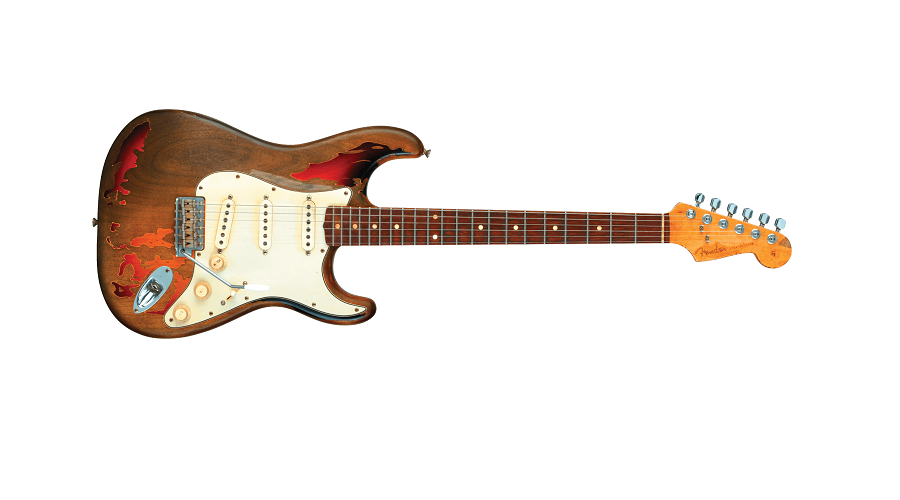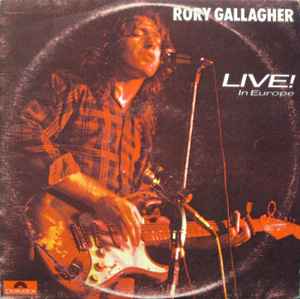Rory Gallagher’s Guitar
The instrument is clearly visible on the cover of “Live in Europe”: beneath the sweaty, soaking wet hair of the guitarist, glowing red, the guitar can be admired. And a marvel it is. There is barely any paint left on the body, only on the edge can you still see that it must have once had a sunburst finish. Above the pickguard, you see only bare wood. This guitar has lived and suffered. As it should in the blues. From September onwards, this guitar will officially be a museum piece.
Rory Gallagher: the Irish blues guitarist known for his raw sound, both vocally and in terms of guitar technique. The man passed away in 1995, but not without leaving behind a tremendous legacy. First and foremost his music, but also his iconic guitar: a 1961 Sunburst Fender Stratocaster. The guitar with barely a trace of paint left was auctioned last October by Bonham’s auction house for nearly nine hundred thousand pounds. There had been queues on the day of the auction: mostly people who wanted to see the guitar live one more time. The new owner, concert promoter Live Nation, then did the only right thing with the guitar: from September, Rory’s guitar will be added to the collection of the National Museum of Ireland.
Rory’s guitar is a unique instrument. Of course, because of its appearance: as if he had run the instrument through a shredder. In several places on the body, only bare wood is visible. The guitar quickly ended up looking this battered—according to family, Gallagher’s sweat literally dissolved the paint. But the appearance isn’t the only thing that makes this guitar unique.
The guitarist from Cork, Ireland, changed just about everything that could be changed on a guitar, to achieve that specific, raw sound. Listen to the album “Tattoo” from 1973, and in particular to the tracks “Tattoo’d Lady” and “A Million Miles Away”. That sound. That’s no standard Stratocaster tone, not the sound the guitar had when Gallagher bought the instrument in 1963 for a hundred Irish pounds.
To achieve that sound, Gallagher replaced the pick-ups. Only the middle of the three single coil pick-ups was still original. He also modified the wiring: the bottom tone knob on the guitar was connected to the volume knob directly below the strings, so he could change both volume and tone with one knob. He replaced the three-way switch for the pick-ups with a five-way switch, giving him more options to engage or disengage pick-ups.
Of course, Gallagher isn’t the only guitarist who heavily modifies a guitar. Especially the Fender Stratocaster—by now the base model is 72 years old—lends itself to drastic changes. Supershredder Yngwie Malmsteen also made significant changes to his Olympic White Stratocasters. The most striking change with Malmsteen is the neck of the guitar: the spaces between the frets—jumbo frets—are scalloped. The effect of this scalloping is that the guitarist can make a note sound with very little finger pressure, the guitar gains faster action—though it does require a technique that few guitarists truly master.
Apparently, modifying a Stratocaster and completely rebuilding it to one’s own specifications is a thing—much more than with a Gibson Les Paul, which usually stays in its original state. David Gilmour made plenty of changes to his black Stratocaster from 1968. Pick-ups, wiring, tremolo, even the jack input for the amp cable: the Pink Floyd guitarist overhauled everything. In 2019, Gilmour sold the guitar for just under four hundred thousand dollars.
And then there are Clapton’s Stratocasters: Blackie and Brownie were true DIY kits. Slowhand once bought six guitars in Nashville, took them apart, and assembled three that were exactly the way he wanted them.
The most famous DIY kit, however, is Eddie Van Halen’s Frankenstrat, although that’s technically not a modified Stratocaster. Van Halen’s famous guitar has Stratocaster parts, including a rejected body and the bridge from a ’58 Strat.
All those modifications have become a market in themselves. Thousands of fans dream of a guitar like their heroes’. And so guitar manufacturers have for some time now released so-called signature models—essentially ‘mutilations’ of the factory models. Van Halen fans get off cheap: for under fourteen hundred euros you can play a Frankenstrat replica. For around 2,600, you can buy a Malmsteen, a “Vintage White” with a scalloped fretboard. A replica of Clapton’s Blackie costs a bit more: for just over four thousand euros you can imagine yourself as Slowhand.
But there is one guitar that takes the crown: the Gallagher Relic Strat, an exact copy of Rory’s guitar. For just over six thousand euros, you get a guitar like the one the Irish blues giant had: with different tuning machines (five Sperzel and one Gotoh), modified pick-ups and tremolo. And of course with the finish that replicates the worn-down look of Gallagher’s guitar. So for six thousand euros, you’re buying a guitar that pretends it has lived.
But all those guitars lack one element: the guitarist himself. There is only one person who can get that specific sound out of such an instrument, who knows exactly how to strike a string, how much pressure to apply on the fret, what quirks the tuning pegs have and how to use them to create certain effects, how to make the notes sing, roar, scream, whistle, and wail.
Rory’s guitar sounded that way because Rory played it. Rough and loud, sometimes very subdued, but always with the right feel so that the guitar did exactly what Gallagher wanted, sounded the way he wanted. On many live recordings you can hear him briefly touch a few strings before really starting a song: feeling it out, tasting, listening—does the guitar give the desired feedback? The guitar was much more than just an instrument. Gallagher himself called the guitar ‘his best friend’, a person, someone alive.
Jimi Hendrix was once asked what it felt like to be the world’s best guitarist. “No idea,” Hendrix reportedly said, “you’ll have to ask Rory Gallagher.”
There is only one guitar that actually smells of its master’s sweat. Whose bare wood tells the story of an Irish boy who bought a guitar for a fortune. A guitar that made him world-famous. That guitar only reveals itself when played by its true owner, although Joe Bonamassa made a respectable attempt when, in 2011, he was allowed by Rory’s brother Donal Gallagher to borrow the guitar for two nights to open his Hammersmith Odeon shows with “Cradle Rock”. A Gallagher song, on Gallagher’s guitar, but it wasn’t Gallagher. Bonamassa didn’t try to be him either: he knows to whom he owes a debt of gratitude and played the instrument with reverence. He too knew that there was only one man who could truly make the Strat cry, moan and spit.
There is, after all, only one Rory guitar. And from September it will stand in a display case, in a museum in Dublin. The guitar will no longer be played, but those who stand before the case and close their eyes will hear the strings vibrate as if touched by an invisible hand. Stay there and listen. Hear the guitar being briefly tuned and then the count-in. Hear “Laundromat”, “Moonchild”, “Bad Penny” or “Shadow Play”.
The guitar will tell the story. Rory on.
Postscript: Joe Bonamassa will give three Gallagher Tribute shows on July 1, 2 and 3 in Cork, Ireland, Rory’s birthplace. There are reportedly still tickets available for July 3.







